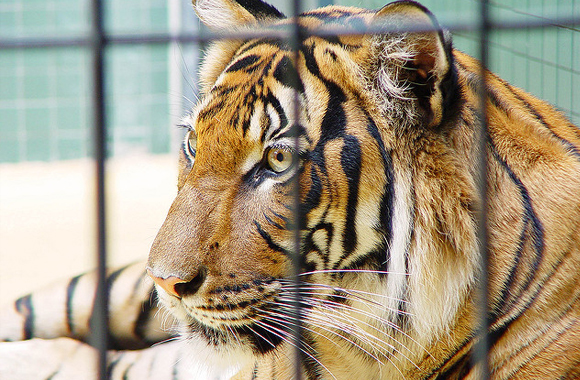Adopt a Tiger!
Help tigers thrive with a symbolic tiger adoption!
About
Tigers are exploited and abused in the wild and in captivity. Wild tigers have been brought to the brink of extinction; fewer than 4,000 remain worldwide, and the number may be as low as 3,000. In fact, more tigers live in captivity in the U.S. than exist in the wild globally.
An estimated 5,000-10,000 tigers are kept as “pets” in the U.S. – more than exist in the wild globally.
Born Free is working to help make sure that tigers are given the best chance at thriving in the wild. In central India, the Satpuda Landscape Tiger Programme (SLTP) is implementing grassroots community conservation activities to prevent conflict between people and tigers. And, Born Free’s sanctuary at Bannerghatta in India provides lifetime care to tigers in need of rescue.
A tiger can be purchased for as little as $300: less than the cost of a purebred dog.
At the policy level, Born Free works within the Convention on International Trade in Endangered Species of Wild Fauna and Flora (CITES) to enforce the international trade ban on tiger parts and products, and to ensure that countries which have tigers (as well as those which have a demand for them) take action to secure a future for the species in the wild.
“The many threats faced by tigers today cannot be underestimated, and how we respond to them now is critical to the tiger’s future.”
Will Travers

Tigers
Status
IUCN Red List Status:
South China tiger – Critically Endangered
Sumatran tiger – Critically Endangered
Amur tiger – Endangered
Indo-Chinese tiger – Endangered
Malayan tiger – Endangered
Bengal tiger – Endangered
Three of the nine tiger subspecies have gone extinct in the last 70 years: the Caspian, Javan, and Bali tigers. The South China tiger will most likely be the next subspecies to be declared extinct.
CITES status: Appendix I
Endangered Species Act Status: All six species of tigers are endangered.
Population
Estimated number remaining in the wild: Fewer than 4,000, and as low as 3,000 (as of 2016)
Population decline of tigers:
Early 1900s – 100,000
1940s – 50,000
2010 – 3,500 (1,400 of whom are in India)
Location
Once ranging widely across Asia, from Turkey in the west to the eastern coast of Russia, the past 100 years have seen tigers disappear from southwest and central Asia, from two Indonesian islands (Java and Bali), and from large areas of southeast and eastern Asia: collectively representing a loss in distribution of over 93% of their historic range. Tigers are currently found in 13 Asian countries, occupying a wide variety of habitats, from freezing boreal forests to hot and humid tropical rainforests:
Amur tiger – Russian Far East and northeastern China
South China tiger – China
Indo-Chinese tiger – Myanmar, Cambodia, China, Laos, Thailand, and Vietnam
Malayan tiger – peninsular Malaysia
Sumatran tiger – Indonesia
Bengal tiger - India, Nepal, Bhutan, Bangladesh, and Myanmar
Size
Tigers are the largest of the big cats, reaching 13 feet in length and 770 pounds.
Fun Fact
Unlike most members of the cat family, tigers like water. They are good swimmers! And, like other patterned animals, a tiger's coat is unique. No two tigers have the same striped pattern.
Related Campaigns
Latest News and Work
June 05, 2018



